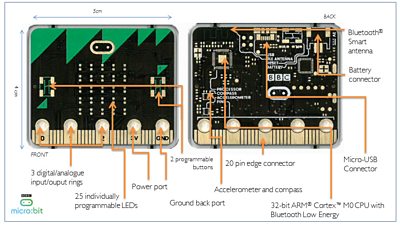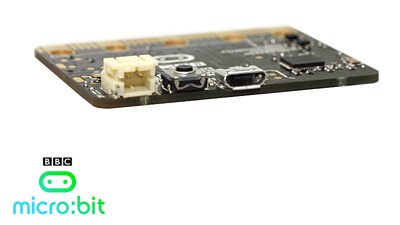Technical Specifications (original) (raw)

Board layout - front
1. Button A (left button with edge connector at the bottom) – labelled A on the board
2. Button B (right button with edge connector at the bottom) – labelled B on the board
3. P0 (left large pin (crocodile clip port) with edge connector at the bottom) - labelled 0 on the board
4. P1 (middle large pin (crocodile clip port) with edge connector at the bottom) - labelled 1 on the board
5. P2 (right large pin (crocodile clip port) with edge connector at the bottom) - labelled 2 on the board
6. +3V - labelled 3V on the board. This is 3V PWR OUT
7. GND
8. P3 – P22 pins from left to right with edge connector at the bottom. Referred to as Pins when referencing that part of the board. Text will talk about 'pins' when referring to individual connections or the general way of connecting to the board – not labelled on the front of the board
9. LED matrix referred as the 'screen' - not labelled on the board
10. LED coordinates starting at 0,0 top left corner - not labelled on the board
The order of the large pins as follows: P0 P1 P2 3V GND labelled 0, 1, 2, 3V GND on the board

Board layout - back
1. USB Plug (Micro-USB plug) – labelled USB on the board
2. Button R (reset button) – labelled Reset on the board
3. Status LED – not labelled on the board
4. Battery socket – labelled Battery on the board
There are additional copper pins on the back of the board that will not be connected to anything. These are to facilitate labelling, while ensuring that a board plugged in the wrong way around doesn't damage any external accessory.
Other components
1. Accelerometer
2. Compass
3. Bluetooth Smart Technology Antenna
4. AAA Battery Holder - not labelled on the board
5. Processor (Cortex M0)
6. P3 – P22 plus P0, P1 and P2 pins from left to right with edge connector at the bottom. Referred to as 'pins' when labelling that part of the board. Text will talk about 'pins' when referring to individual connections or the general way of connecting to the board – labelled PINS on the board
The runtime includes:
- A simple, unified OO model for the device
- A lightweight, non-pre-emptive fibre scheduler
- Managed types for immutable strings and bitmapped images
- A message bus for shipping software and hardware events (eg button presses, device in freefall, scroll text complete)
- LED matrix display driver
- A simple image manipulation library
- Electronic compass driver
- Accelerometer driver
- Button sensor
- Inference-based digital and analogue I/O abstractions
- Bluetooth Smart Technology over-the-air programing
- Bluetooth Smart Technology peripheral mode exposure of runtime components
- Capacitive sense pins